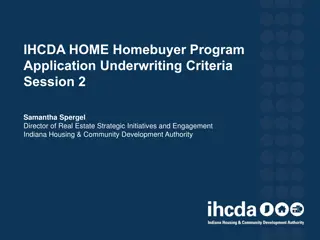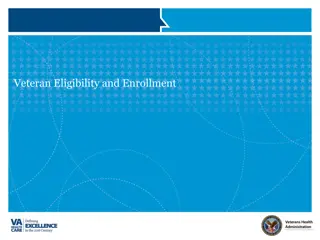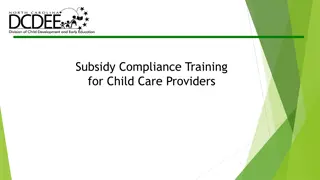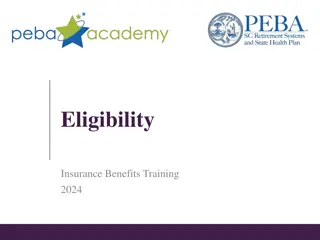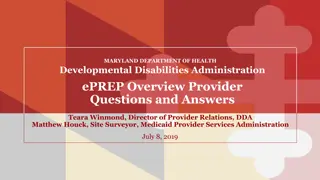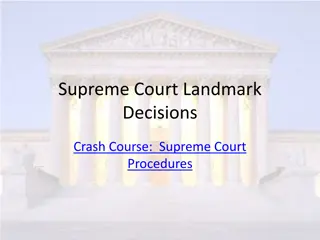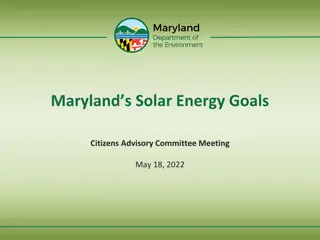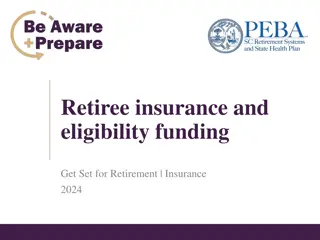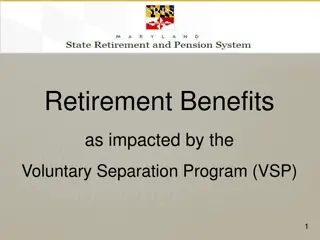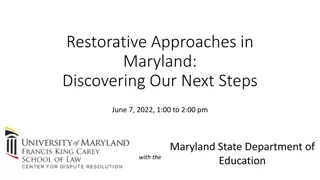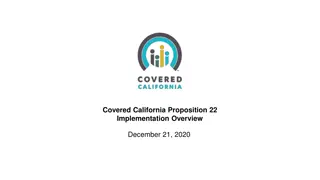Maryland State Health Benefits Eligibility and Subsidy Information
This information outlines the eligibility criteria for health benefits and subsidies offered by the Maryland State for employees and retirees of higher education institutions. It covers conditions based on hire date, years of service, retirement age, and creditable service duration. The details include eligibility requirements, retiree/dependent eligibility, state subsidy availability, prorated subsidies, calculations, and more.
Download Presentation

Please find below an Image/Link to download the presentation.
The content on the website is provided AS IS for your information and personal use only. It may not be sold, licensed, or shared on other websites without obtaining consent from the author.If you encounter any issues during the download, it is possible that the publisher has removed the file from their server.
You are allowed to download the files provided on this website for personal or commercial use, subject to the condition that they are used lawfully. All files are the property of their respective owners.
The content on the website is provided AS IS for your information and personal use only. It may not be sold, licensed, or shared on other websites without obtaining consent from the author.
E N D
Presentation Transcript
If employees Hire Date is prior to 7/1/2011 and retirement directly followsservice with a Maryland State institution of higher education, will be eligible for health benefits if: has at least 5 years of creditable service; or ended at least age 57 with at least 10 years of creditable service; ended State service with at least 16 years of creditable service. If employee s Hire Date is prior to 7/1/2011 but retirement does not directly follow service with a Maryland State institution of higher education, will be eligible for health benefits if: ended State service with at least 25 years of creditable service. 4 4
If employees Hire Date is on or after 7/1/2011 and retirement directly follows service with a Maryland State institution of higher education, will be eligible for health benefits if: ended at least age 57 with at least 10 years of creditable service; or ended State service with at least 25 years of creditable service. If employee s Hire Date is on or after 7/1/2011 but retirement does not directly follow service with a Maryland State institution of higher education, will be eligible for health benefits if: ended State service with at least 25 years of creditable service. 5 5
Retiree/Dependent Eligibility Individuals who are not enrolled in Health Benefits as active employees still have the option to enroll as retirees as long as they meet the eligibility criteria. The same dependent eligibility criteria apply to retirees as active employees. See benefits guide for details. 6
State Subsidy MaximumSubsidy Available if employee: has at least 16 years of creditable service if hired prior to 7/1/2011 or 25 years of creditable service if hired after 7/1/2011. Pro-RatedSubsidy if employee: retirees with less than 16 years of creditable service if hired prior to 7/1/2011 or less than 25 years of creditable service if hired after 7/1/2011 Dependent Subsidy if employee: retirees from a Maryland State institution of higher education must have 25 years of employment for a spouse and dependent children to receive the full subsidy for health benefits. There is no prorated health insurance subsidy for spouse and/or dependents. 8 8 8
Calculating Pro-Rated Subsidy Divide months of creditable service* by 192 months (16 years) if hired prior to 7/1/2011 or 300 months (25 years) if hired after 7/1/2011 (retiree only) Example: (hired prior to 7/1/2011) 60 months (5 years) 192 months (16 years) = 0.3125 0.3125 (31.25%) of the maximum subsidy is what the State will pay toward benefits. Retiree s monthly cost: 0.6875 (68.75%) of the maximum subsidy, PLUS the regular monthly retiree premium. For estimates of premiums with pro-rated State subsidy, call the EBD *Contact EBD for estimate of premiums if less than 25 years. 9 9 9
Retirement and Beneficiaries Spouse (Opposite and Same Sex) Eligible dependents may continue the retiree s health insurance as long as they continue to receive a life time periodic distribution under the ORP. Upon the death of an ORP retiree with 25 or more years of State service, the eligible dependents may continue coverage with the same subsidy. Upon the death of an ORP retiree with less than 25 years of State service, the eligible dependents may continue coverage with no subsidy. 11 11 11
Plans Available to Retirees Medical Plans (Behavioral Health/Vision included with Plan) CareFirst PPO & EPO UnitedHealthcare PPO & EPO Kaiser Permanente IHM (non-Medicare only) Prescription Plans Non-Medicare Eligible Retirees (Regular Rx Plan) Medicare Eligible Retirees (EGWP) Dental Plans United Concordia Dental DPPO Delta Dental DHMO Term Life Insurance If enrolled at the time of retirement, can continue or decrease coverage; may not enroll, increase or add coverage upon or after retirement. Coverage decreases starting at age 65 for retirees. 12 12 12
Plans NOT Available to Retirees Flexible Spending Accounts - According to federal regulations, the plan will only reimburse eligible expenses incurred while still an active employee. Accidental Death & Dismemberment Plan - Can convert to a private policy with Minnesota Life within 30 days of ending active employment. 13
Medicare Is Medicare is the federal program which acts as the primary insurer for eligible retirees and their dependents. The State medical plan acts as the secondary insurer for Medicare eligible individuals. If retired and Medicare eligible due to Age (at age 65) or Disability (at any age) ESRD (End Stage Renal Disease) Parts A (hospital) & B (medical) are required for full coverage. Without Part B, member will be responsible for approximately 80% of claim costs that Part B would have covered. Part D (prescription) is not required if enrolled in the State s EGWP prescription drug plan. 15 15 15
Medicare Parts A & B Enrollment Retiree should contact Social Security approximately 3 months prior to turning 65 to learn about enrolling in Medicare Parts A & B. Once enrolled, retiree and/or eligible dependents should contact EBD with Medicare Health Insurance Claim Number (HICN) along with the effective dates of both Medicare Parts A & B. Retiree group coverage is secondary to Medicare once you are eligible for Medicare coverage, due to age or disability, whether or not you are actually enrolled in Medicare Part B. There is a penalty for late enrollment of 10% for every 12 months the retiree delays enrollment in Medicare Part B past their date of eligibility. 16 16 16
Initial Enrollment Period (Medicare Part B) The Initial Enrollment Period (IEP) for Medicare Part B is a seven month period for Medicare enrollment due to reaching age 65 as follows: If you reach age 65 on the 1st day of the month- Medicare eligibility begins the 1st day of the previous month. If you reach age 65 on the 2nd day through the last day of the month-Medicare eligibility begins the 1st day of the month you turn 65. 17 17 17
Initial Enrollment Period (Medicare Part B) The Initial Enrollment Period (IEP) for Medicare Part B is a seven month period reaching age 65 as follows: Month You Enroll 1st month 2nd month 3rd month 4th (birthday) month 1st day of following month (1-month delay) 5th month Two-month delay 6th month Three-month delay 7th month Three-month delay Month Part B Coverage Begins 1st day of month you reach age 65 1st day of month you reach age 65 1st day of month you reach age 65 18 18 18
Special Enrollment Period (Medicare Part B) There is a Special Enrollment Period (SEP) for Medicare Part B, when member is moving from an active employee-group to a retiree-group coverage and does not turn age 65 within six months (before or after) the month employee-group coverage ends. The penalty for delayed enrollment in Medicare Part B is waived. EXCEPTION: If employee group coverage ends during the Initial Enrollment Period, Special Enrollment Period rules do not apply. Contact Social Security Administration in the first three months of the Initial Enrollment Period (the three months prior to reaching age 65) to find out how to make Medicare Part B coverage begin with retirement. 19 19 19
General Medicare Enrollment Periods Medicare Part B: Enrollment Period: January 1st - March 31st Effective: July 1st If member was eligible but not enrolled in Medicare Part B and did not have health benefits coverage under an active group policy, the Part B premium will be penalized 10% for every 12 months the member was entitled to Part B but not enrolled. Medicare Part D: (other than the EGWP Prescription Drug Plan) Enrollment Period: October 15th December 7th Effective: January 1st If member was eligible but not enrolled in Medicare Part D, or had a continuous gap in coverage of 63 days or more at any point after the beneficiary s Initial Enrollment Period a Late Enrollment Penalty (LEP) is assessed at 1% of the national base beneficiary premium for the coverage year, times the number of uncovered months. 20 20
EGWP What is It? Employer Group Waiver Plan (Medicare Eligible Retiree Drug Plan) Wraps the current prescription drug benefits around Medicare Part D Standard plan Applies to Medicare-eligible retirees only Medicare eligibility due to age OR disability Non-U.S. residents remain in current plan Medicare is primary, State is secondary State plan fills in gaps State retirees and dependents can only be enrolled in one Medicare Part D plan (includes State EGWP plan.) 21 21 21
What Does it Mean to the Retiree? Seamless to retiree still just one ID card No change in copays or out of pocket limits Lower Prescription Drug Premiums!! Brand name differential eliminated Various quantity limits, step therapy, and prior authorizations eliminated No contraceptive restrictions Legend vitamins covered Three out of network fills per year permitted Expanded formulary Monthly statements (EOBs) 22 22 22 22
What Does it Mean to the Retiree? Eligibility requirements: Retirees and dependents residing in the United States who also have Medicare Part A and/or Part B will be enrolled in this plan. Retirees and dependents who do not qualify will retain their current prescription drug benefits. There is no additional premium associated with these plans; the amount paid for by retirees benefits includes the premium for the Medicare Part D benefit. If a member decides to opt out within 21 days of pre- notification, the Retiree and the dependents will lose Rx coverage through the State Program. 23 23 23 23
What Does it Mean to the Retiree? Extra Help Low Income Subsidy Retirees who qualify for low income assistance receive reduced copays and monthly premium reimbursement from CMS. Social Security charges a penalty on the Part D premium for high income retirees ($85,000+) High-income earners may need to pay an additional Part D amount to the Federal government ($85,000 for individuals/$170,000 for married) this is known as D- IRMAA. Members will receive a letter from the Social Security Administration if they are identified as needing to pay this extra amount. 24 24 24 24
Retiree Health Benefit Enrollment and Change Form Obtain a Benefits Guide, an ORP Handbook and an ORP Packet with a Retiree Health Benefits Enrollment Form from: Your Agency Benefit Coordinator (in your agency s HR office). Return your completed ORP Packet and enrollment form with applicable documentation to your Agency Benefits Coordinator who will forward to Employee Benefits Division. 26 26 26
Please Be Aware Enrollment must be submitted to EBD within 60 days of retirement or a qualifying event or the next Open Enrollment. If adding new dependents at time of retirement, submit all required documentation with enrollment form. Kaiser eligibility is based on non-Medicare retirees and/or their dependents. 27 27 27
Notices Retirees May Receive Upon Retirement COBRA Notice/Direct Pay Enrollment Form No Pay letter from the EBD Non Group Bill from your health plan (a conversion bill on health plan letterhead) HIPAA Certificate These forms are printed automatically due to the change in status from active to retiree. 31 31 31
Premium Payments Payments will be made by payment voucher and are due the first of every month with a 30 day grace period. Payments may be made by check, or money order through regular mail OR online through EBD s payment portal. Missed payments or payments not postmarked within the 30 day grace period will result in the termination of your coverage. You will not be permitted to re-enroll until the next Open Enrollment period. 32 32 32
Are you Moving? Please note: You will need to update your address with the Employee Benefits Division in writing in order to ensure delivery of annual Open Enrollment material as well as Explanations of Benefits from the health plans. You may use the Personal Information Change form found at www.dbm.maryland.gov/benefits or send a written notice with signature to Employee Benefits Division. 33 33 33
Now Do You Know? The Big Three Questions: How much will my monthly premiums for health benefits cost if I meet the eligibility requirements? Am I OR anyone on my account required to enroll in Medicare Parts A & B? Is my dependent(s) eligible for subsidy? 34 34 34
Where Can Retirees Get More Information? Express Scripts Member Website www.Express-Scripts.com Order mail order refills Download forms Members can call Express Scripts Medicare Customer Service at 1-866- 557-8211. TTY users should call 1-800-716-3231 Medicare 1-800-MEDICARE (1-800-633-4227). TTY users should call 1-877- 486-2048. www.medicare.gov Social Security Administration 1-800-772-1213. TTY users should call 1-800-325-0778. www.ssa.gov 35 35 35 35
Contact Us Website www.dbm.maryland.gov/benefits Phone 410-767-4775 or 1-800-307-8283 Monday-Friday 8:30 a.m. to 4:30 p.m. Ebd.mail@maryland.gov Cheryl Hill, Administrative Officer III 410-767-4798 Missy Plunkert, Customer Service Manager 410-767-4006 36 36 36



